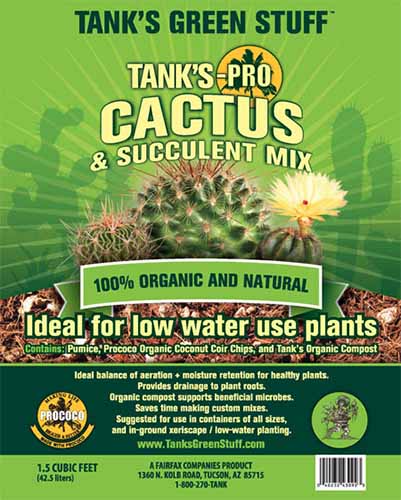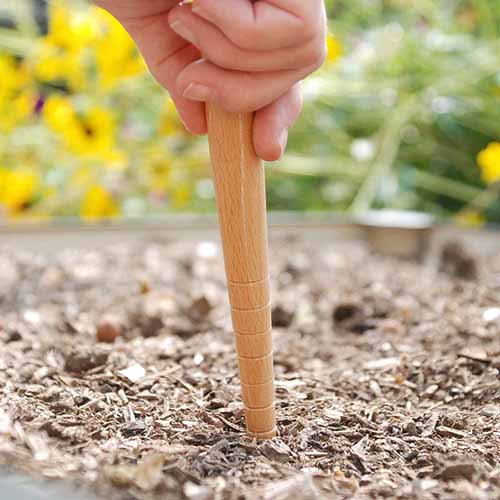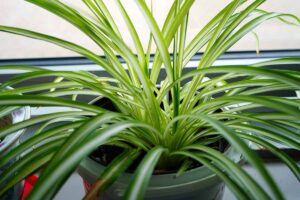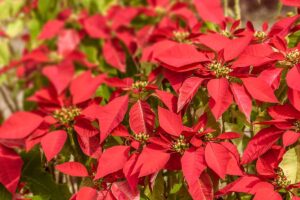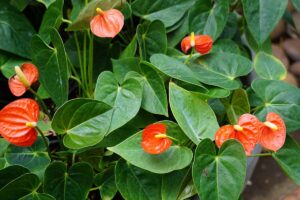Peperomia graveolens
Is there a “ruby glow” on your horizon?
With chunky, green and burgundy leaves, Peperomia graveolens makes an eye-catching succulent houseplant that’s as easy to care for as it is striking!
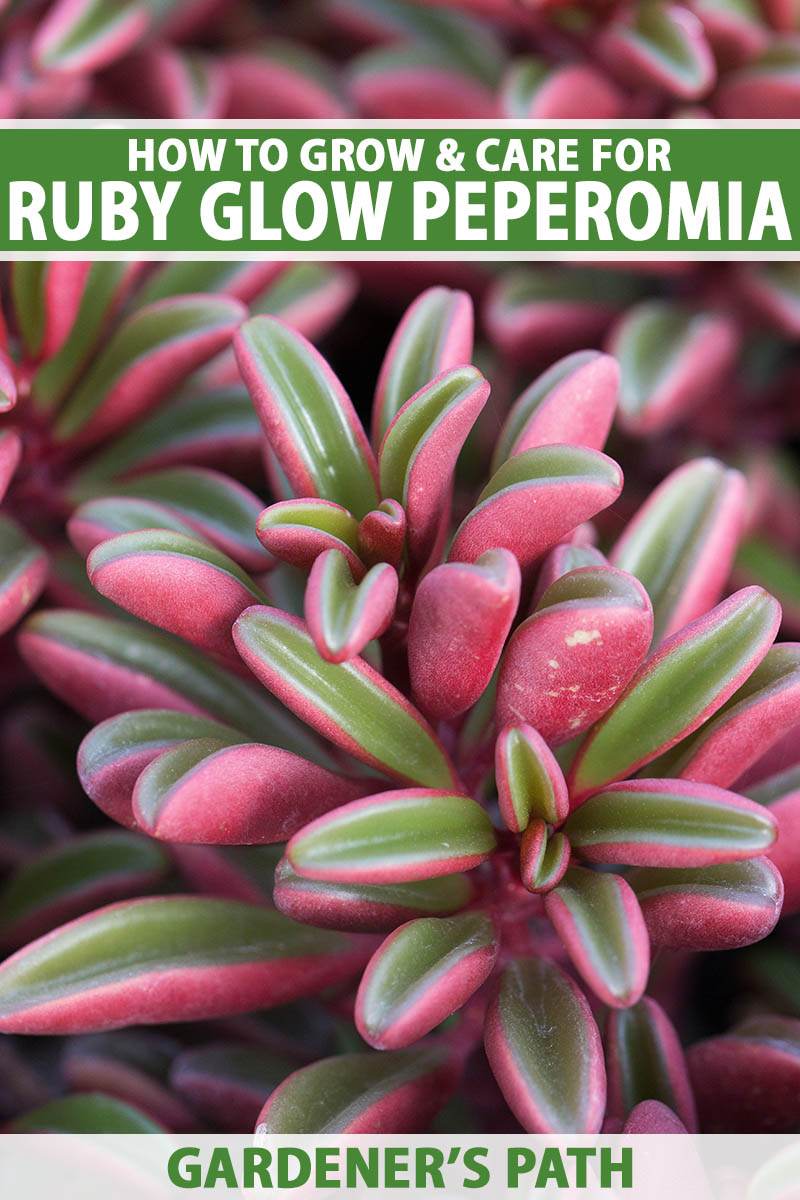
We link to vendors to help you find relevant products. If you buy from one of our links, we may earn a commission.
Once you’ve fallen in love with this stunner of a succulent, you’ll want to know everything about how to take care of it – and that’s exactly what we’ll cover in this article!
Ready to get started?
We’ll be focusing on just one type of peperomia in this article, so if you’re looking for a general guide to radiator plants, be sure to review our complete guide to growing and caring for peperomias.
What Is Peperomia Graveolens?
Also known as “ruby glow” and “ruby glow peperomia,” P. graveolens is indeed a type of peperomia – but one with much more succulent foliage than the types you’ll usually find on offer as houseplants.
With a mounding growth habit, these plants tend to reach eight to 10 inches tall and have a spread of 12 to 18 inches. As plants mature, they take on a more trailing habit.
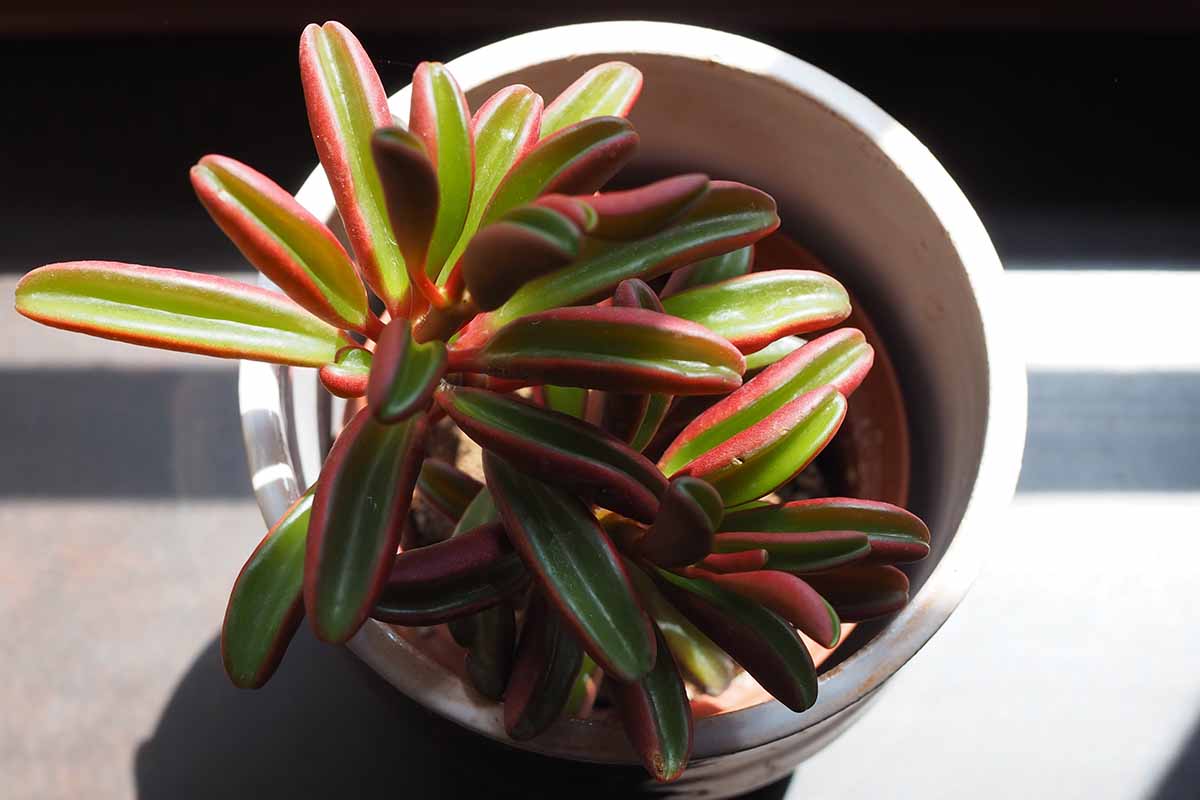
The fleshy, folded leaves of ruby glow peperomia have a canoe-like shape. These succulent leaves are shiny green on top with matte, burgundy-colored undersides, and are attached to wine-colored stems.
Ruby glow peperomia doesn’t often flower when cultivated as a houseplant – and that may be a good thing!
Its inconspicuous flowers, held on a long, thin spike, emit a smell reminiscent of, well, mouse urine.
However, for most houseplant parents, this smell is only detectable if you get your nose very close to the flower spike, so don’t be put off by this less than appealing feature!
Cultivation and History
Ruby glow peperomia is native to Ecuador and this plant has been found living in its native habitat in the Azuay, Loja, and El Oro provinces.
Unlike many other peperomias which are epiphytes, P. graveolens is a terrestrial species, growing on the ground in dry areas of the Andes Mountains.
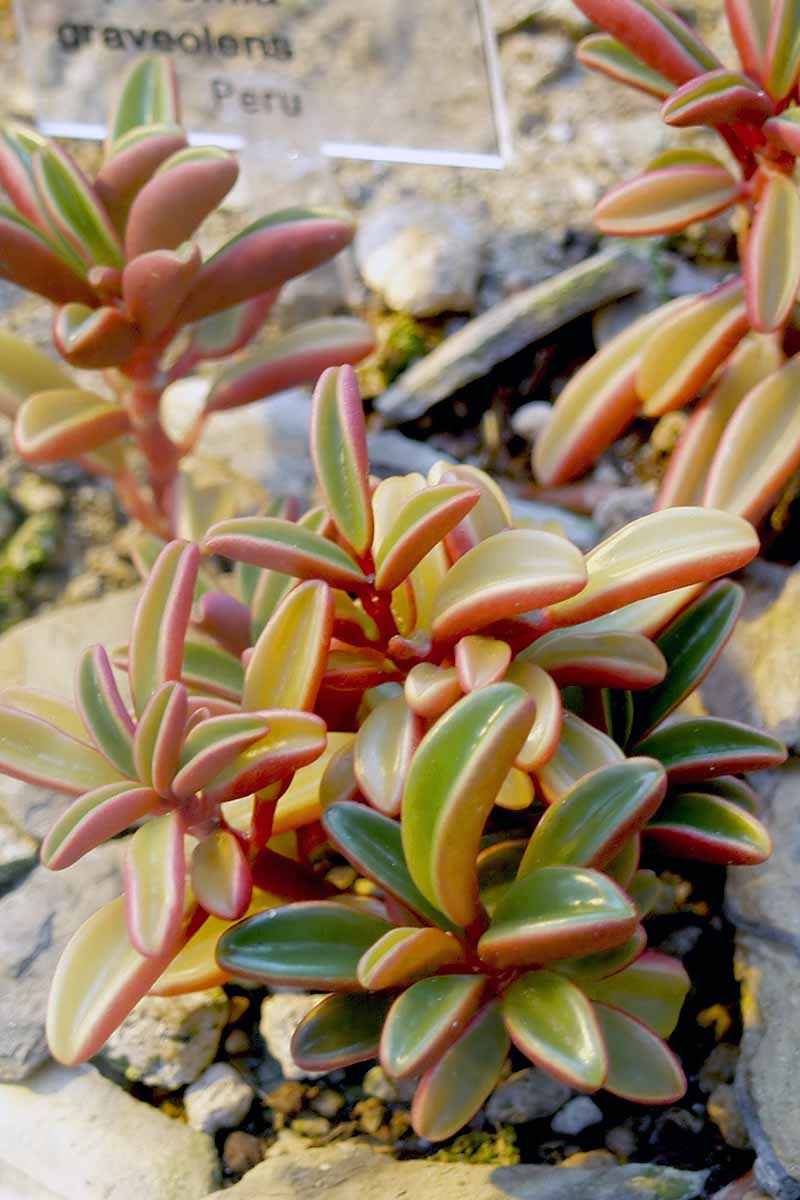
This species is related to other types of peperomias, such as watermelon peperomia and beetle peperomia. Also known as “radiator plants,” peperomias are commonly kept as houseplants.
Ruby glow peperomias are members of the pepper family – and that’s pepper as in “would you care for some cracked pepper?” and not the type that has a Scoville rating.
The genus name Peperomia means “like pepper,” since many of the plants in the genus resemble the black pepper plant, while graveolens means “with a heavy scent” – referring to those malodorous flowers.
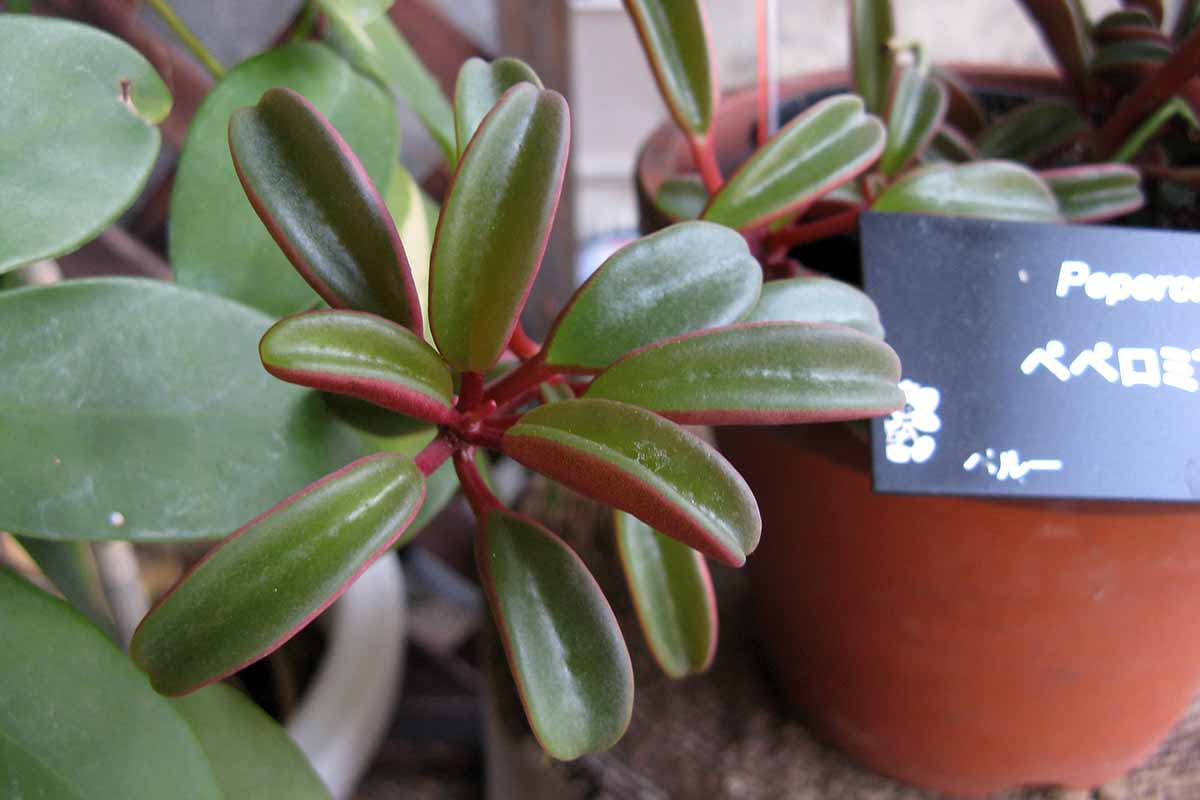
Also known as “ruby peperomia,” P. graveolens is listed as a vulnerable species due to habitat loss, according to The IUCN Red List of Threatened Species.
While cultivated most often as a houseplant, gardeners in USDA Hardiness Zones 10 to 11 can cultivate this succulent plant outdoors year round.
Propagation
These succulent plants rarely produce flowers as houseplants, so seeds are hard to come by.
Instead, count on propagating ruby glow peperomia via stem cuttings – either in water, or in a potting medium. Let’s look at propagating in a growing medium first.
From Stem Cuttings in Growing Medium
Here’s what you’ll need for propagating stem cuttings in soil: a mature plant or cuttings from a friend, sterilized scissors or garden pruners if you haven’t already taken cuttings, two- to four-inch pots, and growing medium.
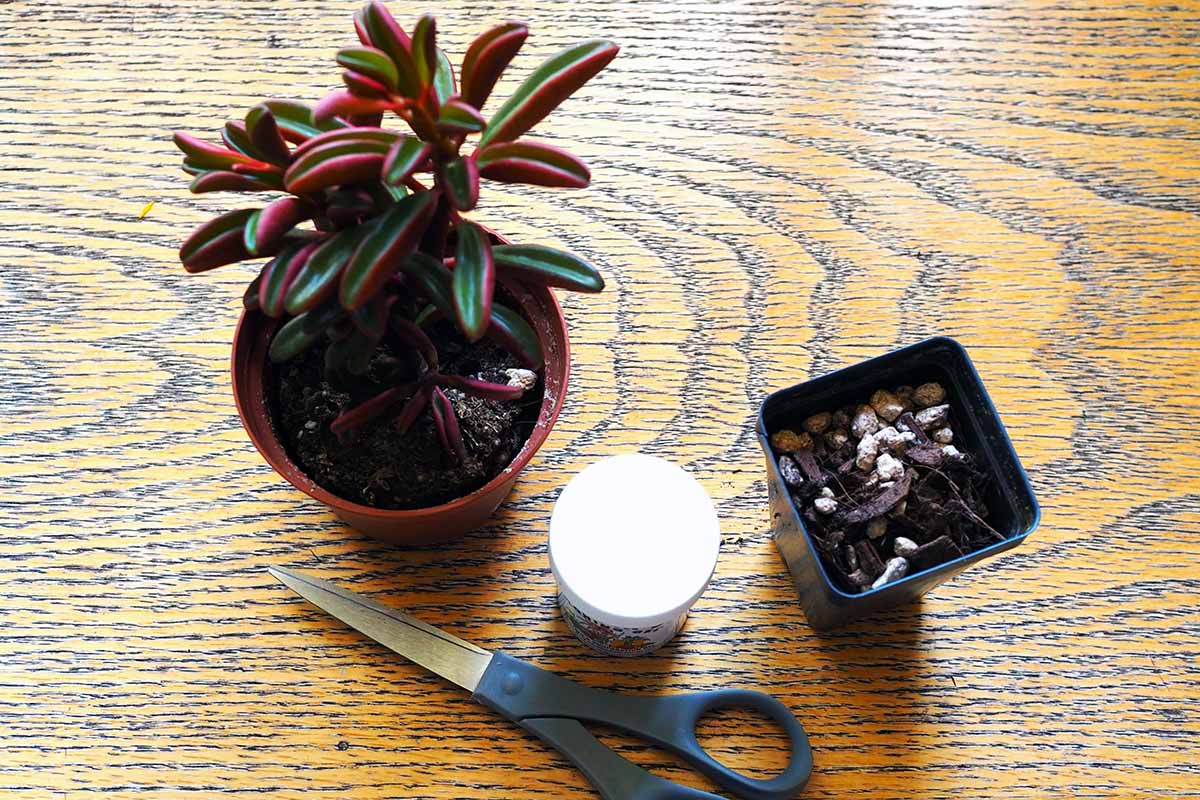
Rooting hormone can also come in handy, but it’s optional.
Use a potting medium designed for cacti and succulents, such as Tank’s-Pro Cactus and Succulent Mix, available in one-and-a-half-cubic-foot bags from Tank’s Green Stuff via Arbico Organics.
Tank’s-Pro Cactus and Succulent Mix in 1.5 Cubic Foot Bag
This growing medium contains pumice, which gives it a good weight, and will help balance the heavy stems of this succulent plant.
If you haven’t yet taken your cuttings, let me point out that this process is going to be a little different than propagating succulent leaves.
Ruby glow peperomia can’t be propagated by rooting leaves alone – a bit of stem is required in addition to the leaf.
The length of the stem cutting isn’t really important.
You can take a short cutting, or a longer one, depending on how much growth you have on the mature plant. The important part here is that there is some stem present, and at least one leaf per cutting.
Do be sure to use sterilized scissors or garden pruners when you take the cuttings to avoid spreading pathogens.
You have options when it comes to how densely to plant your cuttings – you can place one cutting in a two-inch pot, or one in a four-inch pot. If you’re hoping for a bushier specimen, you can also place up to three cuttings in a four-inch pot.
In preparation for sticking the cuttings into the soil, first fill the nursery pots with growing medium, leaving an inch of room between the surface of the soil and the rim of the pot. Otherwise, when you water, the potting medium will spill over the top.
Next, use your finger, a chopstick, or a dibblet, such as this one that’s available for sale at Botanical Interests, to poke holes in the growing medium where you plan to insert the cuttings.
Space the holes out evenly if you’re putting more than one cutting in a pot.
Next, moisten the potting mix.
If using rooting hormone, such as Olivia’s Cloning Gel, available at Arbico Organics, apply it to the wound end of each cutting.

Next, insert your cuttings into the preformed holes in the growing medium and firm up the soil around them.
Keep the soil around the cuttings moist as they take root. A great way to do this without oversaturating the soil is to water the soil surface with a spray bottle.
Place the nursery pots in bright, indirect light while the peperomia cuttings take root.
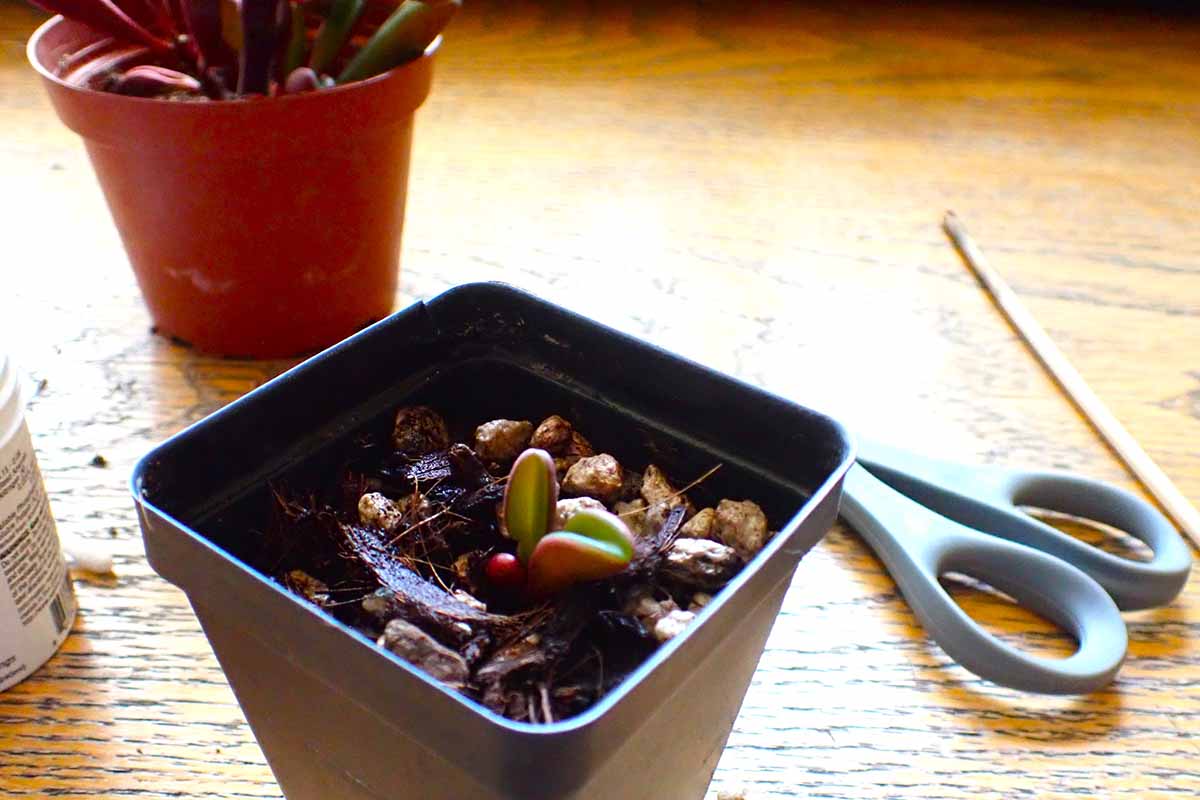
It will take at least a month for cuttings to root, sometimes longer. As long as the cutting still looks like it’s alive, don’t worry, just try to be patient.
Eventually, you’ll notice new growth at the tip of the cutting – take this as a sign that the cutting has started to root as well!
Once the cuttings have put out a few new leaves, you can move them to brighter light if you prefer and transition them to a normal watering routine.
From Stem Cuttings in Water
While propagating cuttings directly in potting medium will save you some time in the end, know that you can also propagate stem cuttings in water if a piece of a plant breaks off and you don’t have time to get out your potting supplies.
Place cuttings in a jar of water, locate them in bright, indirect light, and change out the water regularly to keep it fresh.
After a month or so, you should start to see new growth emerging from the top of the cutting. Check the bottom of the stem around this time, and you will notice small roots emerging as well.
Propagating cuttings taken from this succulent species in water is just a stopgap measure.
Whenever you are ready to pull out your potting supplies, you can transfer them from the water to an appropriate growing medium. You don’t have to wait for them to start producing roots.
How to Grow Ruby Glow Peperomia
Caring for ruby glow peperomias is pretty easy!
These succulent houseplants will thrive in indirect bright light to direct sun, making them an excellent choice for a south-facing windowsill.
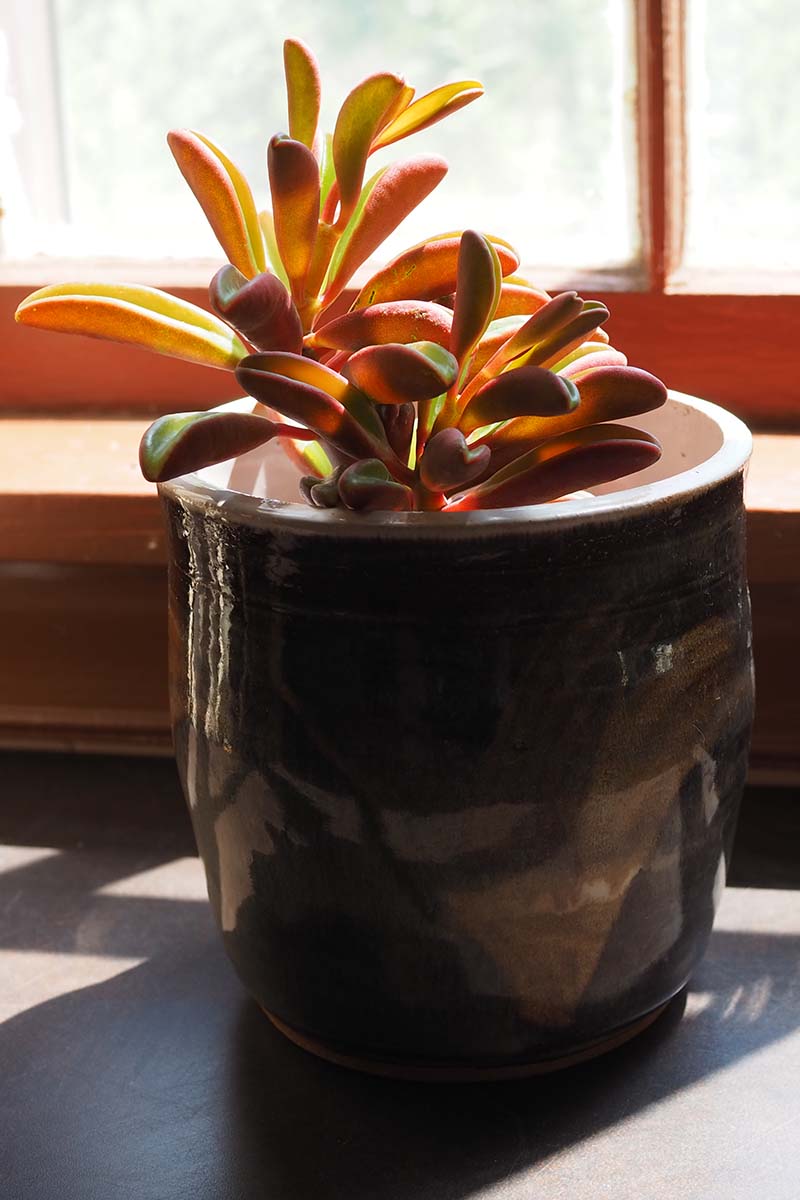
Water them when the growing medium is dry an inch deep, but don’t let it go bone dry.
Also, you’ll need to take care to water less during winter when conditions aren’t as warm, and days are shorter.
When watering, use a watering can designed for houseplants in order to direct moisture past the foliage to the surface of the soil.

As for soil, make sure the growing medium has very good drainage – using a soil mix that is designed for use with succulents will ensure this requirement is met.
Ruby glow peperomias aren’t too fussy about temperature, as seen in their ability to thrive with the fluctuating temperatures of windowsill locations. However, they are not tolerant of frost.
If you allow your houseplants to spend summers out of doors, bring these guys back inside before the weather starts to cool in autumn.
Growing Tips
- Situate plants in full sun to indirect bright light.
- Allow soil to dry to 1 inch between waterings.
- Plant in a growing medium with excellent drainage.
Maintenance
Ruby glow peperomia is a pretty low maintenance choice, so your continuing care for this plant will be fairly minimal.
Don’t repot P. graveolens too often – it will be happier and healthier if kept rootbound.
Like many succulents, these plants are somewhat delicate with leaves breaking off fairly easily, so the first thing to keep in mind when repotting is to handle them with care.
When you do repot, only move plants to the next size pot and make sure to choose a well-draining potting medium intended for cacti and succulents.
If you’d like to learn more about making your own succulent potting medium, be sure to read our article.
Dr. Earth Pump and Grow Indoor House Plant Food
Fertilize this plant during the growing season using a balanced fertilizer, such as Dr. Earth Pump and Grow Indoor House Plant Food, available from Dr. Earth via Arbico Organics.
When using a gentle fertilizer such as this one, you can give your plant a dose each time you water during spring and summer.
As for flowering, if your houseplant decides to produce an inflorescence, you may want to prune it off to avoid smelling the faint but not-so-delectable odor of the flowers.
Use a pair of sterilized snips to trim the inflorescence off at its base.
Where to Buy Ruby Glow Peperomia
When looking for a specimen to add to your houseplant collection, know that this succulent is not one you’ll usually find in the nursery section of your local home improvement store.
You may find it at nurseries specializing in succulents, however.
Online sources are also good bets.
Peperomia Graveolens Ruby Glow in 2.5” Pot
For instance, you can purchase a small ruby glow peperomia in a 2.5-inch pot from Hirt’s Gardens via Walmart.
Managing Pests and Disease
Keeping that houseplant horizon looking rosy and serene, ruby glow peperomia tends to be free of pest and disease problems.
The pests you’re most likely to encounter will be aphids, spider mites, or mealybugs – no strangers to seasoned houseplant parents.
As a first response, all of these pests can be removed with a jet of water from the spray nozzle of your kitchen sink, but do take care not to blast the plant with a hard stream of water, or you may lose some leaves.
If pests return, you may need to resort to stronger stuff – in this case I recommend nontoxic neem oil, which is safe to handle without personal protective equipment, but still gets the job done of taking out unwanted insect visitors.

Theraneem Natural Neem Oil for the Garden 16-oz Bottle
I like Theraneem Natural’s Neem Oil for the Garden for this purpose. It’s available for purchase from Organix South in a 16-ounce bottle via Amazon.
Be sure to follow the manufacturer’s directions for preparing and applying this concentrated product – it needs to be diluted before applying, and may need to be reapplied once a week over two to three weeks before pests disappear for good.
Never apply neem oil to plants in full sun to avoid leaf burn, and always test a single leaf before applying to the whole plant to check for tolerance.
When it comes to disease, ruby glow peperomia should remain disease free unless overwatered or planted in a growing medium or pot lacking drainage, both of which can cause rotting.
Read our article on how to prevent and manage rotting in succulents to learn more.
Best Uses of Ruby Glow Peperomia
As previously noted, ruby glow peperomia is perfectly suited to life on a south-facing windowsill.
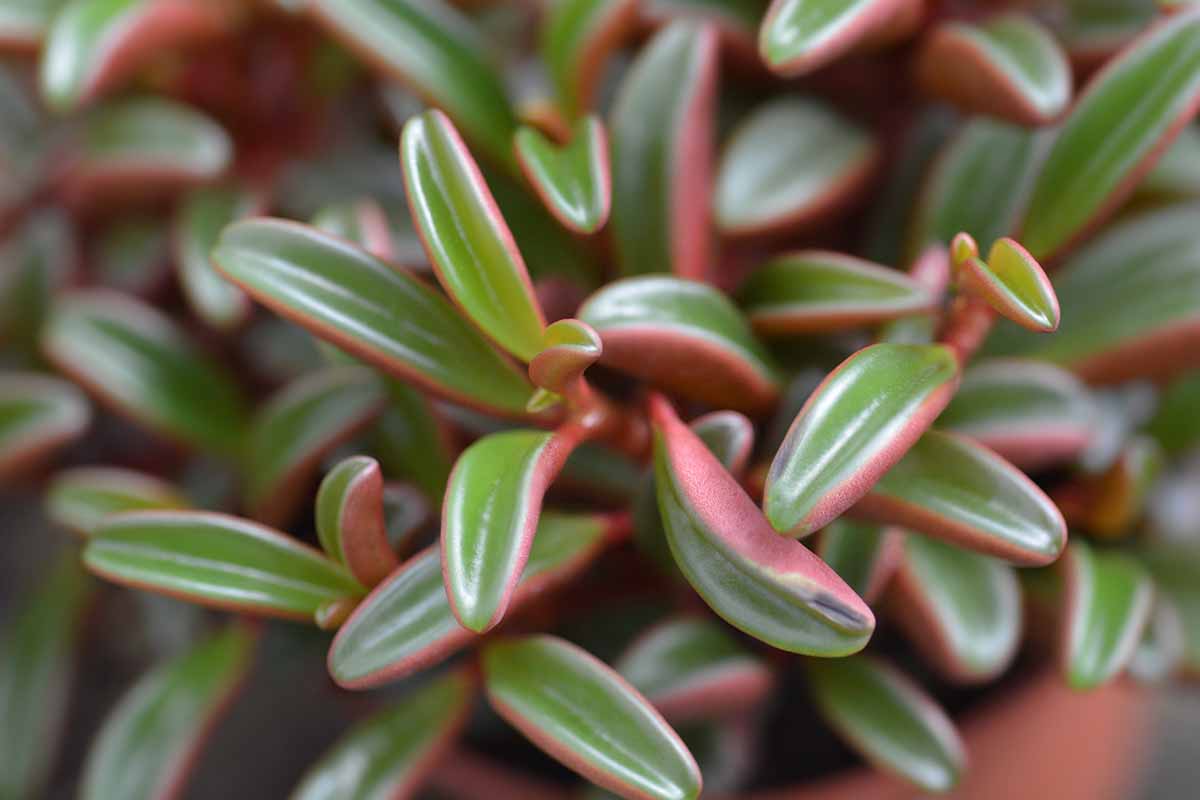
But it can also be situated in a hanging basket or placed in its pot in a macrame hanger.
It joins many other succulents and cacti as being a great trailing plant – mature specimens will trail beautifully over the sides of baskets.
When making arrangements of succulents in a planter, ruby glow peperomia can serve as a filler – or you can use it as a “tree” in a succulent fairy garden!
And in USDA Hardiness Zones 10 to 11, ruby glow peperomia can be used outdoors in dry areas as a ground cover.
Quick Reference Growing Guide
| Plant Type: | Evergreen succulent | Flower/Foliage Color: | Greenish white or yellowish/green and burgundy |
| Native to: | Ecuador | Water Needs: | Low |
| Hardiness (USDA Zone): | 10-11 | Maintenance: | Low |
| Bloom Time/Season; | Spring | Tolerance: | Drought |
| Exposure: | Direct sun to indirect bright light | Soil Type: | Succulent and cactus soil |
| Time to Maturity: | 5-10 years | Soil pH: | 6.1-7.3 |
| Spacing: | 6 inches | Soil Drainage: | Well-draining |
| Planting Depth: | Top of root ball level with surface of soil (transplants) | Uses: | Hanging baskets, indoor fairy gardens, succulent planters, windowsills |
| Height: | 8-10 inches | Family: | Piperaceae |
| Spread: | 12-18 inches | Genus: | Peperomia |
| Common Pests and Diseases: | Aphids, mealybugs, spider mites, whiteflies; root rot | Species: | Graveolens |
Start the Day with a Ruby Glow
When you incorporate this succulent into your home, you’ll have its warm radiance by your side every day.
This perky peperomia is easy to grow and happy to catch some rays on your windowsill – what more could you want?
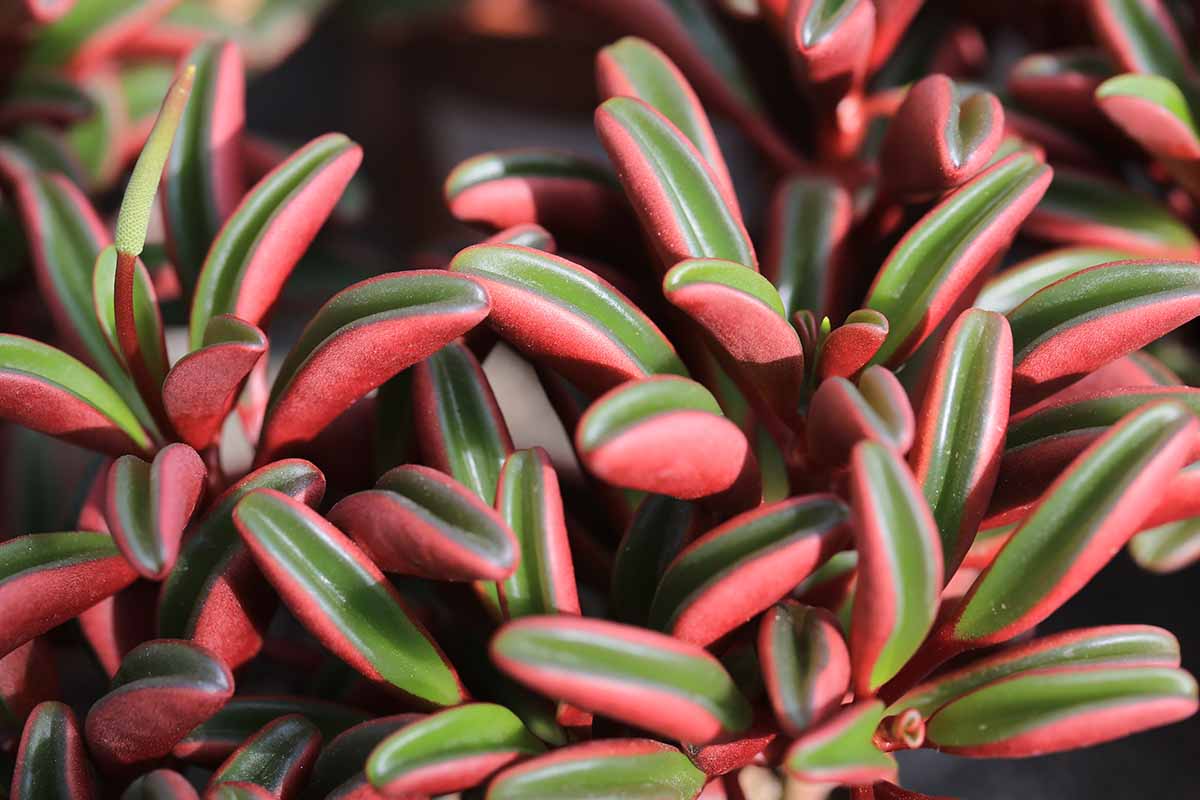
How are you enjoying the company of your own P. graveolens? If you have any great stories about how this plant came into your life, please feel free to share with our readers in the comments section below! And if you need any help troubleshooting, let us know – we’ll be glad to help.
Want to learn more about growing succulent houseplants? Keep reading right here:
